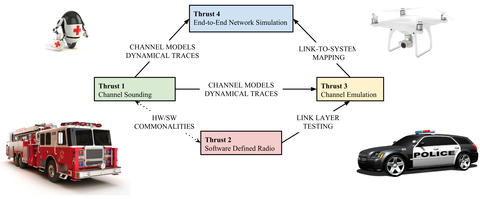End-to-End Research Platform
New York University

Advanced public safety communication (PSC) services call for fast, reliable and low-latency communication technologies, capable of supporting diverse communication modes (aerial, unmanned, vehicular, and peer-to-peer), fast channel dynamics, and ad hoc or mesh structures. For this reason, PSC has been identified as one of the key potential uses cases for the next generation of communication systems, the so-called 5G. In this scenario, the millimeter wave (mmWave) bands and other frequencies above 6 GHz are particularly interesting, since they are largely untapped and offer vastly more spectrum than current cellular allocations in the highly congested bands below 6 GHz, thus enabling orders of magnitude greater data rates and reduced latency. For example, new PSC networks in the mmWave bands could support high-definition video, virtual reality, and other broadband data to large numbers of first responders. Surveillance drones or ambulances could also be provided high-speed connectivity along with machine-type communication for remotely controlled robotic devices entering dangerous areas. However, the way towards this ambitious goal is hindered by a number of open research challenges. In this project, we are working on a test platform for mmWave systems that is functional to the study of such complex scenarios and that we plan to develop as an invaluable tool for realizing mmWave PSC networks. - July 2019
Quick Resources
Meet the Team
Principle Investigator: Sundeep Rangan
New York University
Project Overview
The millimeter wave (mmmWave) bands and other frequencies above 6 GHz hold enormous promise for revolutionizing fifth generation (5G) cellular systems. These frequencies are largely untapped and offer vastly more spectrum than current cellular allocations in the highly congested bands below 6 GHz. With these bandwidths, mmWave cellular systems can enable orders of magnitude greater data rates and reduced latency than networks today. Advanced public safety communications (PSC) has thus been identified as one of the key potential uses cases for these networks.

For example, new PSC networks in the mmWave bands could support high-definition video, virtual reality and other broadband data to large numbers of first responders. Surveillance drones or ambulances could also be provided high-speed connectivity along with machine-type communication for remotely controlled robotic devices entering dangerous areas.
The development of such mmWave PSC networks is in its infancy and will require powerful tools for channel measurement, simulation and emulation if these networks are to be realized in practice. Unfortunately, test platforms for mmWave systems are extraordinarily difficult to build and the few systems available today have focused on cellular and local area network applications. PSC systems have unique requirements including supporting diverse communication modes (aerial, unmanned, vehicular, peer-to-peer), fast dynamics, and ad hoc and mesh structures not addressed by research platforms available today.
Objectives and Approaches
The project proposes the development of a powerful integrated, end-to-end, research platform for the design and evaluation of mmWave PSC networks. The plat-form has four key components that model complex PSC networks at various layers: (1) Phased-array channel sounding for measurement of dynamic directional channels in PSC scenarios, along with a motorized testbed for simulating complex orientation and blocking scenarios; (2) Software-defined radio with a phased-array and powerful baseband processing for prototyping of new ultra-low latency MAC and sychronization algorithms likely to be used in the PSC links; (3) Channel emulation to provide the first scalable real-time emulation of complex mmWave channels in PSC settings; (4) Network simulation: We build the first end-to-end, full-stack, open-source network simulation. Collaborations with the Austin Fire Department will develop realistic, complete test scenarios.
Anticipated Challenges
The development of mmWave test systems for complex PSC scenarios is daunting. Link layer emulation must support high data rates, ultra-low latency, and must accurately model spatial channels and advanced phased arrays. Network simulation must support a wide diversity of communication modes, high mobility, complex blocking, and large numbers of nodes. This emulation and simulation demand massive computational power and large-scale testbeds. We develop novel approaches that modularize the simulation problem and gain computational simplicity and flexibility for various communication modes and scenarios to be encountered in PSC settings.
Benefits and Impacts
The research platforms envisioned in this proposal address core parts in the development cycle of a complex wireless system, and will thus be invaluable for realizing mmWave PSC networks. By leveraging existing extensive platform work at NYU WIRELESS along collaborations with the University of Padova, our industrial affiliates and a fire department collaborator, the proposal has a unique opportunity to greatly accelerate the time to bring mmWave PSC technologies to market. All the development and data will be made open-source enabling academic labs, industry and government agencies to build on these tools.

